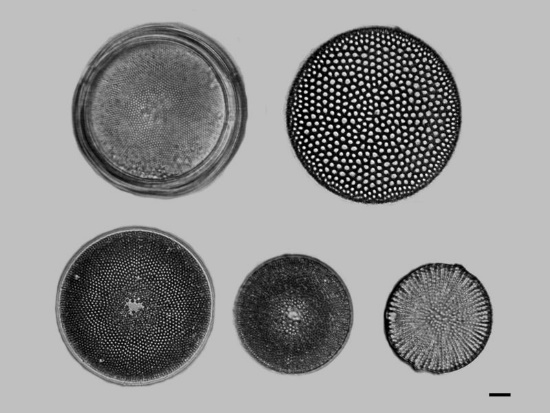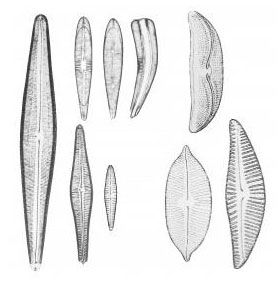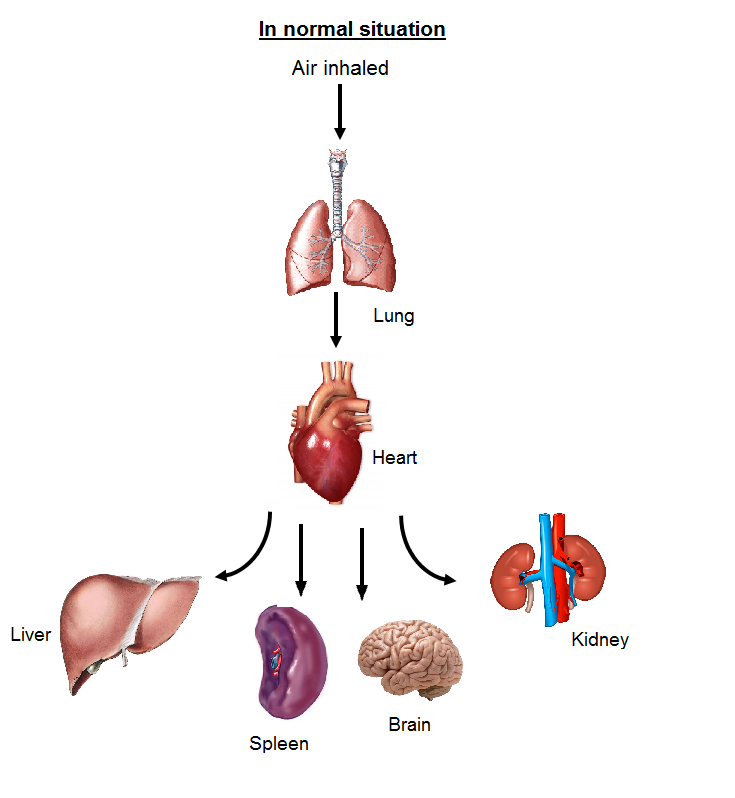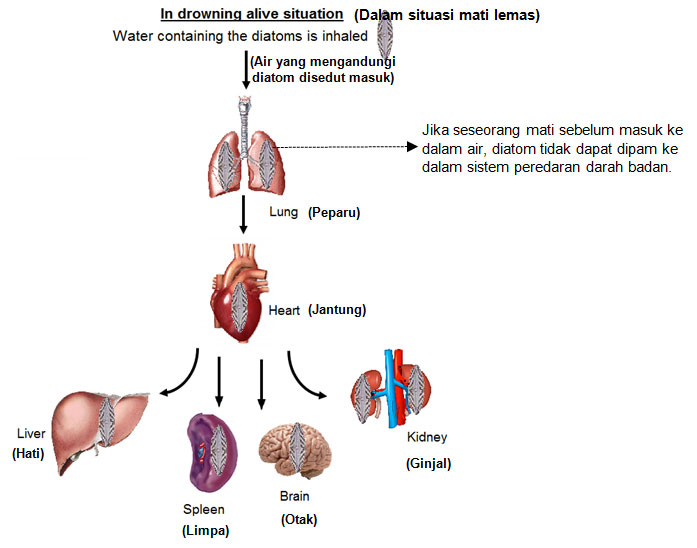Diatoms are a group of unicellular photosynthesizing algae that can be found in aquatic or semi aquatic environment, including oceans, freshwater, river, lakes, ponds, hot springs, snow and even tap water. According to Van Den Hoek et al. (1995), about 12,000 species of diatoms have been identified and belonging to over 250 genera that have been described from marine, fresh water and terrestrial habitats. Currently, it is believed that there may be as many as 100,000 species of diatoms in total.
Morphology Of Diatoms
Traditionally, diatoms are identified distinctly from other algae based on the features of their frustules ( ![]() cell wall). The frustule is transparent and made of silicon dioxide hydrated with a small amount of water (Si02 + H20). Silicon dioxide or more commonly known as silica, is the main component of glass and hence, diatoms are often called “algae in glass houses”. Frustule consists of two halves called valves, which fit neatly together like the two halves of a Petri dish as shown below. Each valve is also equipped with one or more girdle bands. The upper valve is known as epitheca and the lower valve as hypotheca.
cell wall). The frustule is transparent and made of silicon dioxide hydrated with a small amount of water (Si02 + H20). Silicon dioxide or more commonly known as silica, is the main component of glass and hence, diatoms are often called “algae in glass houses”. Frustule consists of two halves called valves, which fit neatly together like the two halves of a Petri dish as shown below. Each valve is also equipped with one or more girdle bands. The upper valve is known as epitheca and the lower valve as hypotheca.
Classification Of Diatoms
Diatoms are named scientifically as ‘Bacillariophyta’ (botanical name for diatoms). There are a number of ways to classify the diatoms and up till this present time, none of the classification is universally standardized. One of the most commonly used classification is described by Round et al. (1990), where they have divided diatoms into three classes based on their morphology, namely Coscinodiscophyceae (centric diatoms), Fragilariophyceae (araphid pennate diatoms) and Baccilariophyceae (raphid pennate diatoms).
| Diatom class | Example |
| Coscinodiscophyceae (centric diatoms) | |
| Fragilariophyceae (araphid pennate diatoms) | |
| Baccilariophyceae (raphid pennate diatoms) |
Different water habitat possesses different species of diatoms, for instance, freshwater diatoms are different from marine diatoms. Besides this, the quality of the water like pH, sunlight exposure, nutrients and salinities of the water will greatly affect the size, shape and colour of the diatoms. Hence, every water source has its own diatom profile that makes it unique and different from each other.
Usage Of Diatoms
Not many people realize the existence of diatoms in our life although they play multiple important roles in our daily life and also contribute extensively in the study of environmental science (ecology and paleontology).
Some of the prominent usefulness of diatoms will be introduced briefly below:
- Daily life
- The heavily siliciated frustules of diatoms and the fine structures of their cell wall make them a superb natural filter to be used in fluids, medicine, solvents, chemicals and beverage industries.
- Owing to their light, tiny and sustainable structure, diatoms are used as filler for paper, paint, ceramics and detergent.
- Diatoms are used as heat and sound insulators.
- In old days, diatoms are used to improve the optical imaging quality of microscope and also mild abrasive in toothpaste.
- Paleontology
Diatoms are widely used in the various studies of Palaeontology, which comprises of paleoclimate analysis, paleolimnology, paleoceanography, paleotemperature analysis, paleoproductivity of lake or sea, indicators for period of glaciation and deglaciation
From the point of view of Paleontology, diatoms are also very useful indicators for various analysis, including:
- Indicators of Paleo-pH
This is one of the most widely uses of diatoms in paleontology as diatoms are highly pH sensitive. By studying the pH of diatoms, it can categorize the fossil species into different pH groups, which is useful in studying history of fossils.
- Indicators of Salinity
This is to study the salinity ranges of diatoms, especially in determining the zonation of marine and freshwater.
- Indicators of Productivity (Trophic Status)
Total diatom count, centric:pennate ratio, indicator for species, planktonic:non-planktonic ratio, indicators for diversity are applied to test the productivity of the water.
- Indicators of Paleo-temperature
Analyses of temperature range of diatoms are used to compare the hot, warm and cold water ecologically.
- Indicators of Paleo-pH
- Environmental Science and Ecology Science
Diatoms are currently used as a tool to indicate the pollution index in aquatic habitat, such as seas, oceans, rivers, lakes, ponds, glacier, and so on.
- Forensic Limnology
Unknown to most people, diatoms are actually used in investigating drowning case, i.e. Forensic Limnology.
Forensic Limnology
As mentioned in the book like “The Green Revolution: Botanical Contributions to Forensics and Drug Enforcement”, Limnology and Diatoms and Forensic Science, diatoms analysis is one of the major analysis in Forensic Limnology that is applied particularly for investigation of drowning cases.
What is Forensic Limnology? It is a sub-field of Forensic Botany. It makes use of living organisms in water in the investigation of forensic related cases. Currently, the most popular analysis in Forensic Limnology is using diatoms as supporting evidence for drowning cases.
History Of Using Diatom Test For Investigating Drowning
1896 – Diatom was first detected in lung fluid by Hofmann.
1904 – Rovenstoff had successfully utilized diatom to solve a mysterious case of drowning.
1942 – Incze successfully detected diatoms in blood and parenchymal organs.
1949 – Tamasaka detected diatom in bone marrow.
1960’s – 1970’s – Timperman used large series of drowning cases that provided evidence for the validity of diatom test.
How?
There are two important questions that can be answered by using diatom analysis for drowning cases:
- Has this person died from drowning or was this person dead prior to ‘entering’ the water?
- Has this person drowned in the water source where the body was found?
Question 1: has this person died from drowning or was this person dead prior to ‘entering’ the water?
When a person breathes, the air will be drawn into the lung which brings in oxygen and the heart pumps to circulate blood to all parts of the body including vital organs like liver, kidney, spleen etc. But, if a person dies, the lungs and heart will stop functioning so as to cease air from being drawn into the lungs and heart from pumping blood.
If a person drowns, he/she will struggle in the water and at the same time, the water (diatoms present in the water) will enter the respiratory tract. When the heart pumps the oxygenated blood, the diatoms will then enter the blood circulation and disseminate into the various organs within the body.
Hence, when diatoms are found in the lungs, liver, kidney, heart, spleen and even brain, the person has most likely drowned in the water source. In other words, when diatoms are present in all the organs, it positively indicates that the person has died from drowning.
Conversely, when diatoms are absent in all the organs, the cause of death needs to be investigated further as it could be death from other causes besides drowning. When a person has died prior to ‘entering’ the water source, his/her respiratory and circulatory systems will have ceased functioning. Under such condition, diatoms are unable to enter the circulatory system or the organs within the body. Moreover, there may be a situation where only diatoms are found in the lungs and in such situation, it cannot be confirmed that death was due to drowning because diatoms can enter passively into the lungs via the respiratory tract.
Question 2: Has this person drowned in the water source where the body was found?
As mentioned above, different water sources and water types possess different species of diatoms, not to mention that some diatoms are only specific to certain water source. Thus, when freshwater diatoms are detected in the body that was found in the sea further investigation need to be done to look for the original scene of body of water.
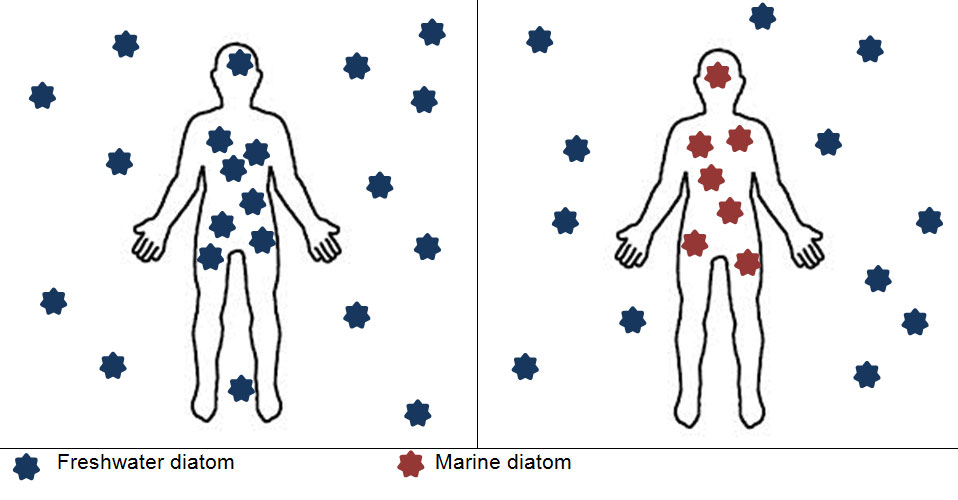
If the species of diatoms found in the body match with the species of diatoms from the freshwater where the body was found, it positively supports the fact that the person has drowned in that particular water source. (Left) If the species of diatoms found in the body are totally contrary to the diatoms recovered from the water source, one must be cautious in interpreting that the person has drowned in that particular water source as it could be that the person has died elsewhere and then disposed at the current scene where the body was found.
There are certain species of diatom(s) which are specific to certain water source. This can help us locate the original drowning scene despite the body being removed and disposed at another scene where the body was found.
In conclusion, there are lots of debates and arguments with regards to the usage of diatoms analysis in confirming drowning cases. However, it is undoubtedly that diatoms can be used as a guide as well as supportive evidence to concur with the circumstances of drowning. Post mortem examination will still be the gold standard in confirming the cause of death.
References
- Coyle, Heather Miller; Carll Ladd; Timothy Palmbach; Henry C. Lee (2001). “The Green Revolution: Botanical Contributions to Forensics and Drug Enforcement”. Croatian Medical Journal (2001): 340–345
- Dommelen, Jennifer Van (17 June 2005). “Limnology”. Forensic Botany. Dalhousie University. Retrieved 29 September 2012.
- Horton, Benjamin P. (27 October 2007). “Diatoms and Forensic Science”. Paleontological Society Papers: 14–22.
- http://westerndiatoms.colorado.edu/about/what_are_diatoms
- http://www.answers.com/Q/How_do_you_use_diatoms
- http://www.ucmp.berkeley.edu/chromista/diatoms/diatomlh.html
- https://answers.yahoo.com/question/index?qid=20100323220544AAo2zXU
- Kelly, M., Identification of common benthic diatoms in rivers, Volume 9.4, 2013.
- Kumar, M., Deshkar, J., Naik, SK., Yadav, PK., (2012). “Diatom Test – Past, Present, and Future: A brief Review. IJRRMS: 2(3).
| Last Reviewed | : | February 2024 |
| Writer | : | Chong Sin Leng |
| Reviewer | : | Nurhusni binti Mohammad Room |



